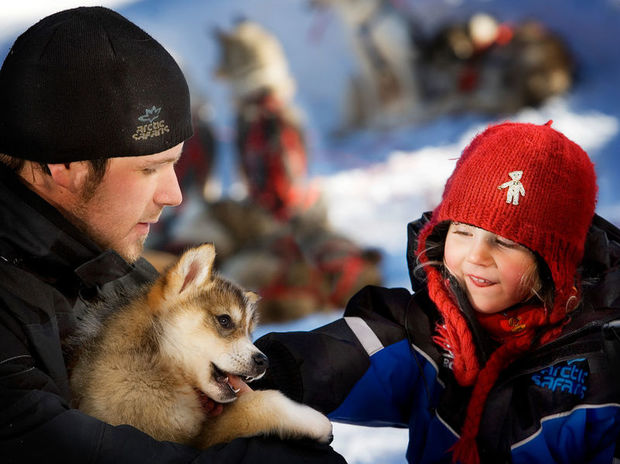A dog sledding experience is the chance to get the pulse racing with a tradition that dates back millennia. You’ll also get up close to the noble animals that are – in spite of their great strength and tenacity – incredibly friendly and impeccably trained. It’s the perfect activity addition to any winter holiday. In this guide, we’ll point you towards the best husky holidays in Scandinavia and mush you between the sport’s rich history and tips on how to steer.
History of husky sledding
Termed ‘man’s best friend’, dogs have been used for transport since the 10th century BC when sleds were first used in Canadian migrations north of the Arctic Circle. Since then, the tradition has been adapted by Arctic explorers, Alaskan pioneers chasing the gold rush and Native Americans to the south, looking for an alternative to the horse. Famously, in 1925, 20 teams of dogs in relay transported a serum over 1,000 kilometres to Nome in Alaska’s remote west. It took them just over five days, saving the town from an imminent diphtheria outbreak.
Husky sledding culture
As the earliest archaeological evidence – found in Canada – points to dog sleds being used for transport and to extend the winter hunt, dog sledding was once an integral part of life for remote communities. The first sleds made use of just a single hound pulling minimal cargo – such as firewood – before the need to pull larger loads over longer distances saw teams of dogs first put together. According to formal records, it took until the mid-19th century for dog sled races to take hold. Today, Europe’s premiere race, Norway’s Finnmarkslopet, features hundreds of entrants competing over courses of up to 620 miles.
Tips when husky sledding
Although most introductions to dog sledding are made with a musher who’ll be able to show you the ropes, ahem, reigns, here a few things to bear in mind:
- Wrap up warm; this is a winter activity. A balaclava is an excellent addition considering that you’re travelling at speed through the Scandinavian cold.
- Get to know your dogs. To help socialise their huskies, visitors are always encouraged to visit the pens to interact with the puppies who are well used to being around humans.
- Don't be fearful. Despite their size and piercing blue eyes, this playful nature won’t be lost in the adult dogs.
- Trust the dogs. Huskies are very intelligent and will know the route better than you.
- As with biking, let your body-weight do the turning. Travelling up to 20 mph is no mean feat.
- Yellow snow is a thing.
Where to go husky sledding
Despite being available throughout northern Scandinavia, there are a couple of locations that really stand out. For a true taste of the wilderness, head to the centre of Swedish Lapland for the Aurora Safari Camp where you’ll stay in a traditional lavvu (Sámi tent) and chase the aurora borealis far from the dazzling glare of any artificial lights. And, with only two dog sleighs out at any one time, you’ll enjoy a perfectly intimate experience. For something a touch more accessible, Tromso, Norway’s adventure capital, is ideal for those looking to combine husky sledding with a host of other winter activities, including snowshoeing, whale watching, reindeer sledding and sea fishing.

Ethics of husky sledding
Whenever animals are involved, it’s important to consider their fair treatment and use. Thankfully, the dogs used have been bred for thousands of years and are specifically adapted to pulling; from around six months, they’re trained on light loads to build up muscle before moving onto the sleds. And, the breeds – often Siberian or Alaskan huskies – are known for their boundless energy, needing constant exercise. As such, they’re much better suited to sled dashes than lazy park walks. At Best Served Scandinavia, we only work with husky sledding companies that are fully comply with European animal treatment laws, and we regularly visit our husky sledding partners to ensure the standards of welfare match our exacting standards.
Inspired? Take a look at our winter holidays, or call our specialists to start planning your trip.





